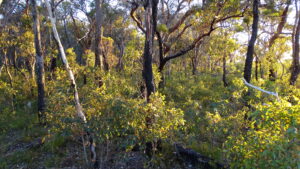Reducing the impacts of future fires
Background
In 2020, the San Diego Zoo Wildlife Alliance (SDZWA) Plant Conservation Team provided funding to the ANPC to support plant conservation actions (aligned with the recommendations of the Federal Threatened Species Scientific Committee (TSSC) for Post-fire Recovery), to meet the aims of:
1. Supporting the nomination and listing of fire as a Key Threatening Process.
SDZWA funding (in combination with other funding sources) enabled the nomination and listing of ‘Fire regimes that cause biodiversity decline’ as a Key Threatening Process (KTP) in 2022 under the national Environment Protection and Biodiversity Conservation Act (EPBC Act) through supporting the assessment and preparation process, in collaboration with experts from the TSSC, and lead authorship of the major technical report Fire regimes that cause declines in biodiversity – Advice to the Minister for the Environment from the Threatened Species Scientific Committee on amendments to the List of Key Threatening Processes under the Environment Protection and Biodiversity Conservation Act 1999.
2. Researching how to reduce the impacts from future fires.
SDZWA funding also helped develop guidance on recovery actions to build the resilience of biota to future fires, through publishing the following reports and articles aimed at building the human contribution to such resilience, by quantifying the mechanisms of risk and investigating new approaches to reduce the incidence of future fires:
- Two chapters in Australia’s megafires: Biodiversity impacts and lessons learned from 2019-2020 (Gallagher et al. 2023 and Lindenmayer et al. 2023).
- Zylstra (2021) Linking fire behaviour and its ecological effects to plant traits, using FRaME in R.
- Zylstra et al. (2022) Self-thinning forest understoreys reduce wildfire risk, even in a warming climate.
- Zylstra (2022) Quantifying the direct fire threat to a critically endangered arboreal marsupial using biophysical, mechanistic modelling.
- Zylstra et al. (2023) Mechanisms by which growth and succession limit the impact of fire in a south-western Australian forested ecosystem
- Zylstra (2023). Fires of the future.
- Zylstra (2024) Reconciling fire behaviour science and forest ecology.
- Zylstra et al. (2024) Reply to comment on “Self-thinning forest understoreys reduce wildfire risk, even in a warming climate”
 (a)
(a)  (b)
(b)
Understorey dynamics in Jarrah forest exemplify the drivers of fire risk measured in Zylstra et al. (2022). Recently burned Jarrah (a) has a dense understorey of germinated shrubs and saplings that burned seven times more frequently than the same forest left unburnt for around 50 years, which develops an open understorey (b). Processes of growth and forest succession such as self-thinning and self-pruning act as ‘ecological controls’ on wildfire spread and severity (Zylstra et al. (2022a). Photos: Philip Zylstra
References and further reading
Auld, T.D., Zylstra, P., Makinson, B., Coates, D. and Lynch, J. (2022). Assessing impacts and recovery after the 2019/2020 fires of priority plant species that were not previously threatened. Australasian Plant Conservation 31(2), 36-40.
Auld, T.D., Zylstra, P., Makinson, B., Coates, D. and Lynch, J. (2024). Preventing rare plant extinction and reducing impacts of future fires. Australasian Plant Conservation 33(1), 12-17.
Department of Agriculture, Water and the Environment (2022). Fire regimes that cause biodiversity decline as a key threatening process. Canberra, ACT.
Gallagher, R.V., et al. (2023). Blackened roots and green shoots: emerging trends in decline and recovery in Australian plant species after the 2019–20 wildfires. In: Australia’s megafires: Biodiversity impacts and lessons learned from 2019-2020. Eds Van Leeuwen, S., Wintle, B.A., Woinarski, J.C.Z., Rumpff, L. and Legge, S.M. CSIRO Clayton South, Vic. Pp. 111-126.
Lindenmayer, D.B., Bowd, E., Taylor, C. and Zylstra, P.J. (2023). Interacting and compounding impacts: fire and forestry in the 2019– 20 wildfires. In: Australia’s megafires: Biodiversity impacts and lessons learned from 2019-2020. Eds Van Leeuwen, S., Wintle, B.A., Woinarski, J.C.Z., Rumpff, L. and Legge, S.M. CSIRO Clayton South, Vic. pp 255–68
Zylstra, P.J. (2021). Linking fire behaviour and its ecological effects to plant traits, using FRaME in R. Methods Ecol. Evol., 12, 1365–1378.
Zylstra, P.J., Bradshaw, S.D.A. and Lindenmayer, D.B. (2022). Self-thinning forest understoreys reduce wildfire risk, even in a warming climate. Environ. Res. Lett., 17, 044022.
Zylstra, P.J. (2022). Quantifying the direct fire threat to a critically endangered arboreal marsupial using biophysical, mechanistic modelling. Austral Ecology, 00, 1-23.
Zylstra, P.J., Wardell-Johnson, G.W., Falster, D.S., Howe, M., McQuoid, N. and Neville, S. (2023). Mechanisms by which growth and succession limit the impact of fire in a south-western Australian forested ecosystem Funct. Ecol. 37 1350–65.
Zylstra, P. (2023). Fires of the future. Wild 52–5
Zylstra, P. (2024). Reconciling fire behaviour science and forest ecology. Australasian Plant Conservation 32(3), 18-20.
Zylstra, P. J., Bradshaw, S. D. and Lindenmayer, D. B. (2024). Reply to comment on “Self-thinning forest understoreys reduce wildfire risk, even in a warming climate” Environ. Res. Lett. 19 058001.

